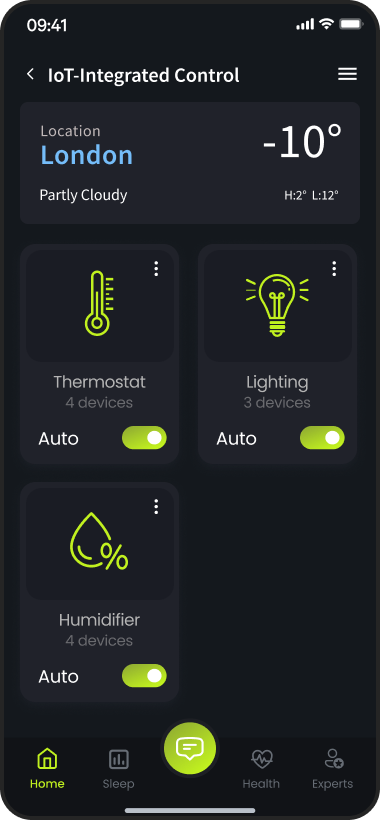Sleep Eden
Master’s Degree Design Project: IoT-Integrated Sleep Improvement System
01 SUMMARY
Quality sleep is a cornerstone of well-being, yet modern lifestyles, particularly our reliance on screens, severely disrupt it. Blue light emitted from devices inhibits melatonin production, hindering natural sleep cycles. Paradoxically, many sleep aids themselves are screen-based, perpetuating the problem. Sleep Eden tackles this by offering a holistic, screen-free solution.
Leveraging research on sleep-impacting factors like noise, light, and stress, we’ve developed a smart wristband that integrates with IoT devices. This system provides personalized sleep insights and environmental adjustments, moving beyond generic remedies to address individual needs.
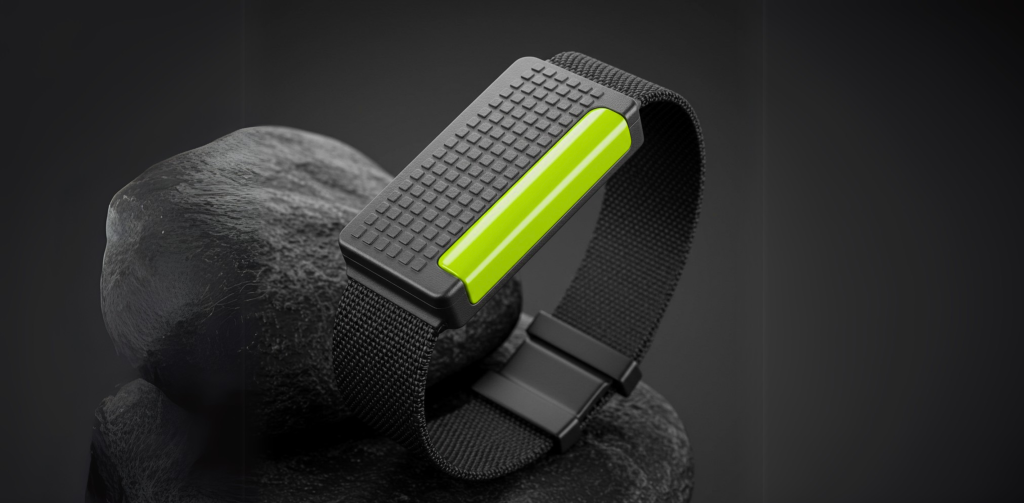
02 MY ROLE
This was an individual design project where I conceptualized the smart wristband and its accompanying mobile app. I led the end-to-end design process, from translating research insights into user-friendly interfaces to designing the seamless integration with IoT devices.
My focus was on creating a screen-free, personalized sleep improvement solution, emphasizing the wristband as the primary data collection tool and delivering actionable insights through the mobile app. This included designing user flows, visual interfaces, and prototypes, ensuring a holistic and user-centered approach to enhancing sleep quality.
03 THE PLAN
To develop a personalized, screen-free, and IoT-integrated sleep improvement system that empowers users to achieve consistent, quality sleep by addressing multifaceted sleep factors and creating a holistic sleep environment
User Research & Feature Definition: Conducted 12 in-depth interviews to understand individual sleep challenges, informing the core feature set of Sleep Eden.
Broader Validation & Data Collection: Developed a survey questionnaire to gather wider insights and validate initial findings on sleep disruption factors.
MVP Development & Iterative Testing: Created a MVP to test core functionalities and gather user feedback for iterative improvements.

04 DISCOVERY
USER INTERVIEWS
I conducted in-depth interviews with 12 individuals experiencing sleep-related challenges. The following key takeaways were identified and integrated into the Sleep Eden solution:





QUESTIONNAIRE
We will begin our evaluation by administering a questionnaire to 20 participants (ages 20-60). This will provide data on sleep perception, quality, conditions, and goals, which will directly guide the integration of features into the Sleep Eden prototype.
90%
Non-Medication Preference: Approximately 90% of participants prefer non-medication solutions for sleep problems, indicating a strong demand for alternative sleep aids like Sleep Eden.
42%
Difficulty Returning to Sleep: Roughly 42% of participants struggle to fall back asleep after waking during the night, highlighting a need for Sleep Eden’s screen-free, re-sleep assistance.
32%
Desire for Improved Sleep: Majority of participants recognize a gap in their sleep quality, as only 32% report achieving the recommended amount, indicating a clear need for a sleep solutions.
EARLY SKETCHES FOR THE DEVICE
To visualize the core concept of Sleep Eden—a screen-free, distraction-free sleep solution—I developed preliminary sketches focusing on the physical design of the wristband.
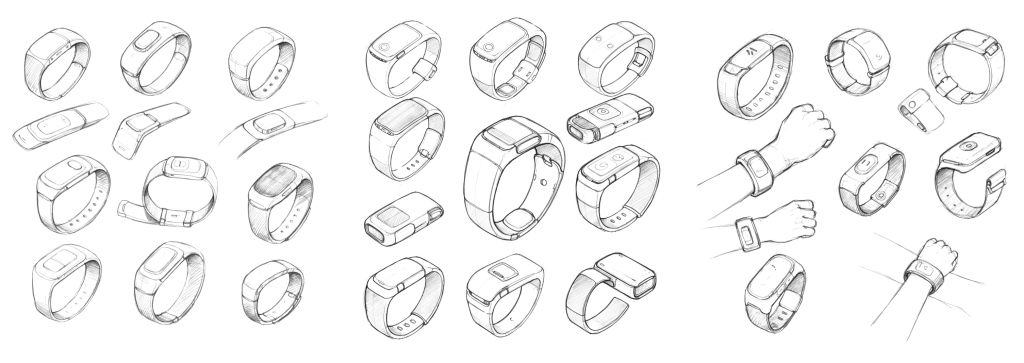
05 SOLUTION
FLOW OF INFORMATION
Sleep Eden goes beyond data tracking, delivering meaningful insights that empower users to understand their sleep and make informed improvements.

MAIN FEATURES
To provide personalized sleep improvement, Sleep Eden incorporates these core features:
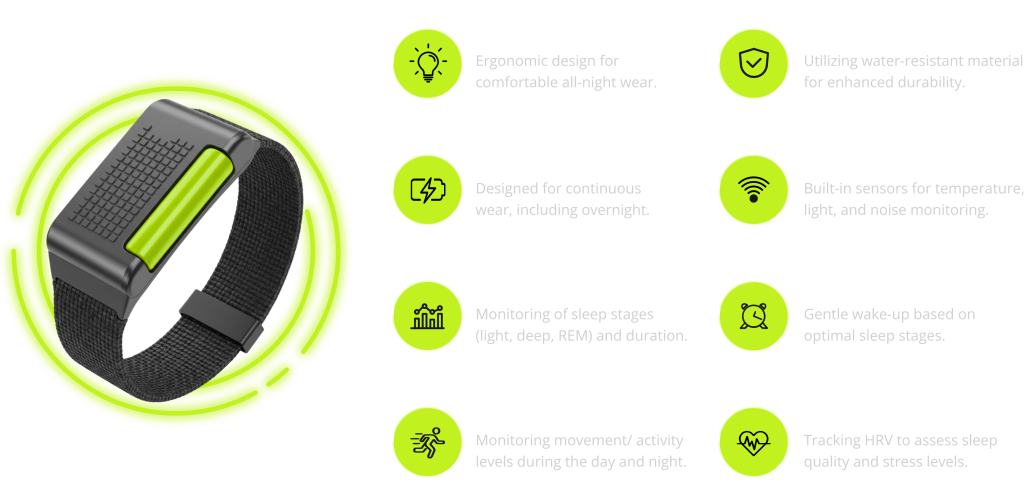
SLEEP INSIGHTS
Leveraging the Sleep Eden band, app tracks daily, weekly, and monthly data, including average sleep time, sleep duration, sleep schedule, heart rate fluctuations, and detailed sleep stage analysis (REM/NREM).
This data is then used to generate personalized exercises and tailored treatment plans.

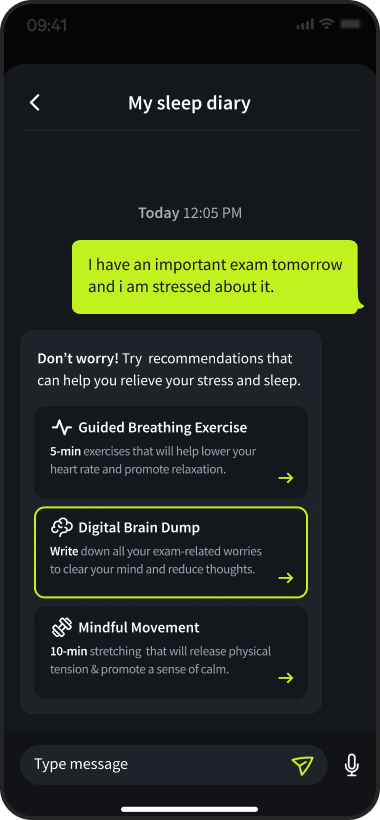
AI-POWERED SLEEP DIARY
Users can log sleep triggers, track disruptions, and document activities that improve sleep.
Integrated AI analyzes this data, along with the information from the Sleep Eden band, to identify potential sleep disorders to suggest management techniques and healthy screen usage advices.
IoT – INTEGRATED CONTROL
Integrated sensors (accelerometer, heart rate, light, and temperature) connect seamlessly with the mobile app and other smart home devices.
As the user’s routine bedtime approaches, the app automatically adjusts environmental factors like room temperature and lighting to create an optimal sleep environment, ensuring a smooth transition to sleep.
